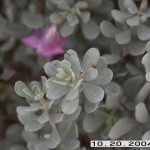Cenizo, Purple Sage, Texas Silverleaf
Leucophyllum frutescens (Berl.) I.M. Johnst.
Scrophulariaceae (Foxglove family)
Description
Cenizo is a short, unarmed native shrub in the Figwort (Scrophulariaceae) family growing up to 8 ft or 2.5 m tall. It is the most widespread of Texas’s three Leucophyllum species and one of the state’s most beautiful shrubs. Cenizo is a colorful plant that usually stands out in the native range, especially when flowering. It is used extensively as an ornamental. Its ashy-gray leaves and colorful flowers after rainfall help with field identification. The elliptical to obovate leaves are short, measuring less than 1 inch or 2.5 cm. Its leaves are hairy (short, matted or tangled, soft & woolly), ashy gray, simple, and either cluster along the stems or are located alternately along the stems. A dense layer of fine hair gives the leaves their distinctive ashy-gray color. Cenizo is an evergreen in most of its zones. The solitary, bell-shaped flowers which emerge from the leaf axils while only about 2 cm (about 0.79 in), are showy, pale violet to purple or pink (rarely white), and have external and internal hairs. The flowers are bi-lateral, two-lipped, and five-lobed with dark spots on their throat. Bloom time is from May to October, but Cenizo often blooms right after rainfall. The fruit is a many-seeded, two-valved capsule. The seeds measure about 8 mm (about 0.31 in) and are wrinkled. On old trunks, the bark is grayish-black and rough with small scales. The forage value for Cenizo is fair for livestock and wildlife.Habitat
In Texas, Cenizo is common on rocky limestone or caliche hills, and in arroyos and chaparral. It does well on poor but well-drained soil. It is most common south of Menard County to Travis County line.Images
Plant Characteristics
Flower Color: Pink, Purple, White
Seed Type: Capsule
Duration: Perennial
Stem Texture: Hairless/Smooth
Growth Habit: Shrub (Woody)
Leaf Shape
 : Simple with Pinnate or Parallel Venation
: Simple with Pinnate or Parallel Venation
Season: Warm
Distribution
 : 02 - Gulf Prairies and Marshes, 05 - Cross Timbers and Prairies, 06 - South Texas Plains, 07 - Edwards Plateau, 10 - Trans-Pecos
: 02 - Gulf Prairies and Marshes, 05 - Cross Timbers and Prairies, 06 - South Texas Plains, 07 - Edwards Plateau, 10 - Trans-Pecos
Distributions
Distribution refers to the ecological region in Texas that a plant has been found. You can also view a clickable map.
Book: Brush and Weeds of Texas Rangelands (B-6208)
Collection: Brush and Weeds





